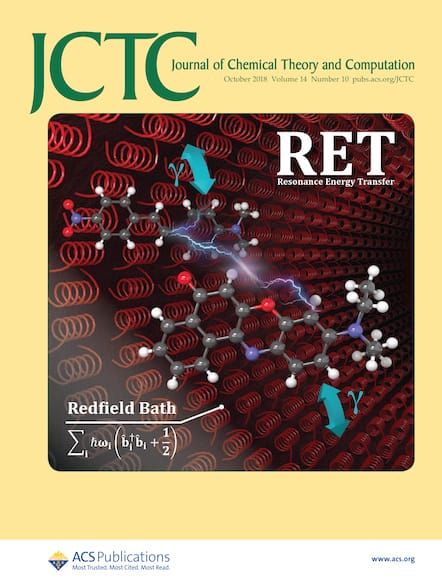Mixed Quantum/Classical Theory Approach to Rotationally Inelastic Molecular Collisions Implemented on a Quantum Computer.
IF 5.7
1区 化学
Q2 CHEMISTRY, PHYSICAL
引用次数: 0
Abstract
All elements of a quantum algorithm for calculations of rotationally inelastic molecule + atom scattering within the framework of a mixed quantum/classical theory are outlined. In this approach, the rotational motion of the molecule is described quantum mechanically using the time-dependent Schrödinger equation, while the scattering process of two collision partners is treated classically. The matrix of potential coupling is precomputed on a classical processor, whereas the quantum hardware is used to propagate the system of coupled equations for the rotational state-to-state transitions. All quantum circuits needed for practical implementation of the algorithm are presented. First, the quantum codes written in Qiskit are rigorously tested by running calculations for a N2 + O collision on a classical emulator of quantum hardware using a realistic potential energy surface of this system and comparing these results against the results obtained by the MQCT code. Next, these codes are run on the actual quantum hardware, such as the publicly available IBM Brisbane, Kyiv, and Sherbrooke. A very good agreement with benchmark data was obtained. To the best of our knowledge, this is the first proof-of-principle calculation of inelastic scattering implemented successfully on a quantum computer using a case study within mixed quantum/classical framework.在量子计算机上实现旋转非弹性分子碰撞的混合量子/经典理论方法。
概述了在混合量子/经典理论框架内计算旋转非弹性分子+原子散射的量子算法的所有元素。在这种方法中,分子的旋转运动使用时间相关Schrödinger方程进行量子力学描述,而两个碰撞伙伴的散射过程则采用经典方法处理。势耦合矩阵在经典处理器上预先计算,而量子硬件则用于传播旋转状态到状态转换的耦合方程系统。给出了实际实现该算法所需的所有量子电路。首先,使用Qiskit编写的量子代码在经典量子硬件模拟器上运行N2 + O碰撞计算,并使用该系统的真实势能面对其进行严格测试,并将这些结果与MQCT代码获得的结果进行比较。接下来,这些代码在实际的量子硬件上运行,例如公开可用的IBM Brisbane、Kyiv和Sherbrooke。所得结果与基准数据吻合良好。据我们所知,这是在混合量子/经典框架内使用案例研究在量子计算机上成功实现的第一个非弹性散射的原理证明计算。
本文章由计算机程序翻译,如有差异,请以英文原文为准。
求助全文
约1分钟内获得全文
求助全文
来源期刊

Journal of Chemical Theory and Computation
化学-物理:原子、分子和化学物理
CiteScore
9.90
自引率
16.40%
发文量
568
审稿时长
1 months
期刊介绍:
The Journal of Chemical Theory and Computation invites new and original contributions with the understanding that, if accepted, they will not be published elsewhere. Papers reporting new theories, methodology, and/or important applications in quantum electronic structure, molecular dynamics, and statistical mechanics are appropriate for submission to this Journal. Specific topics include advances in or applications of ab initio quantum mechanics, density functional theory, design and properties of new materials, surface science, Monte Carlo simulations, solvation models, QM/MM calculations, biomolecular structure prediction, and molecular dynamics in the broadest sense including gas-phase dynamics, ab initio dynamics, biomolecular dynamics, and protein folding. The Journal does not consider papers that are straightforward applications of known methods including DFT and molecular dynamics. The Journal favors submissions that include advances in theory or methodology with applications to compelling problems.
 求助内容:
求助内容: 应助结果提醒方式:
应助结果提醒方式:


